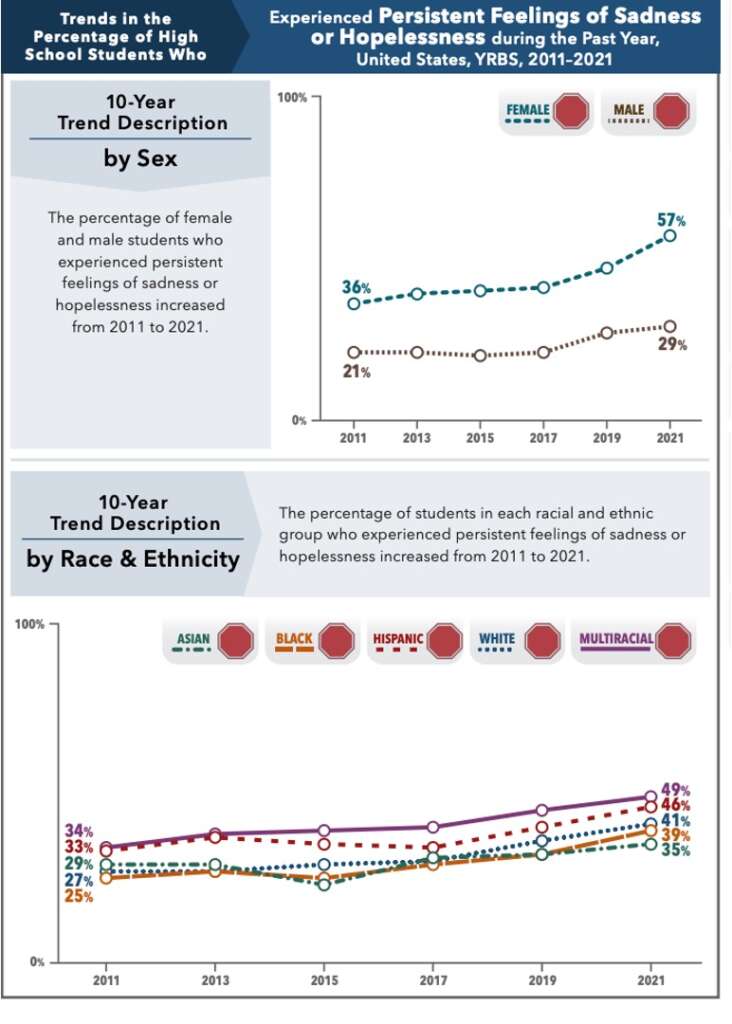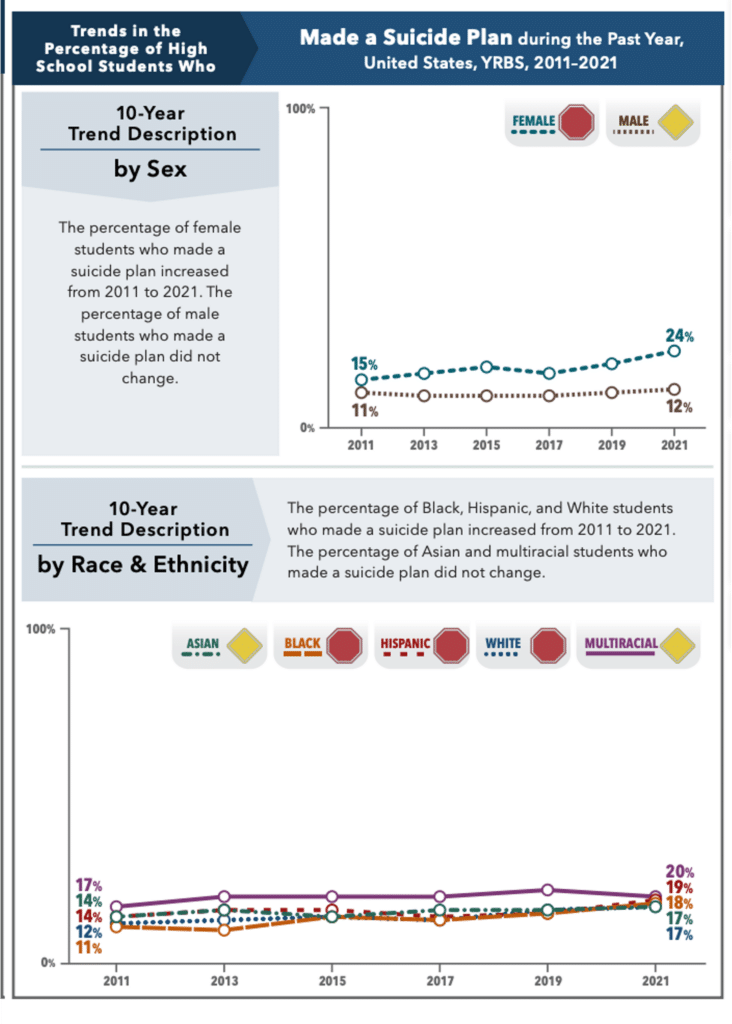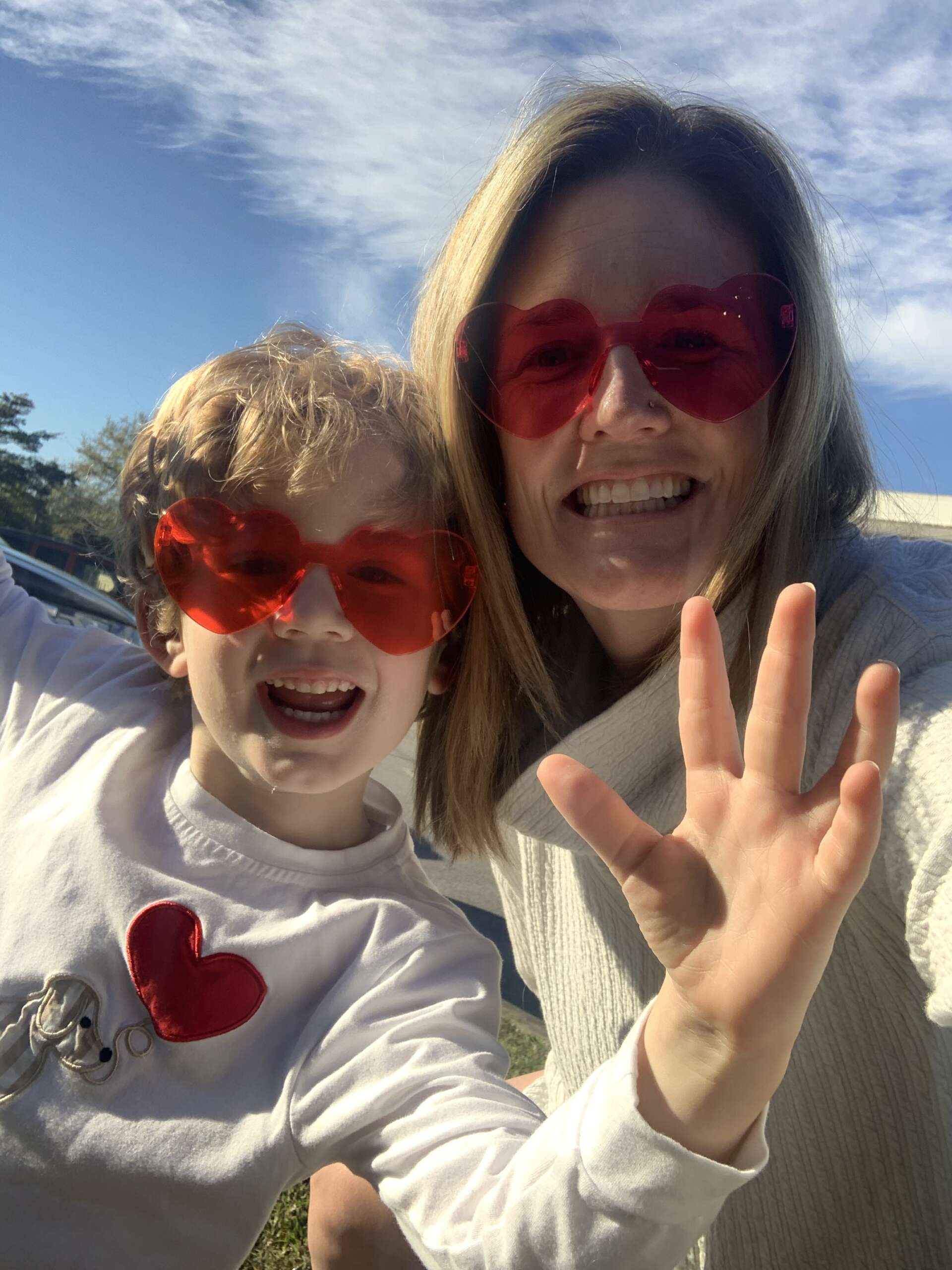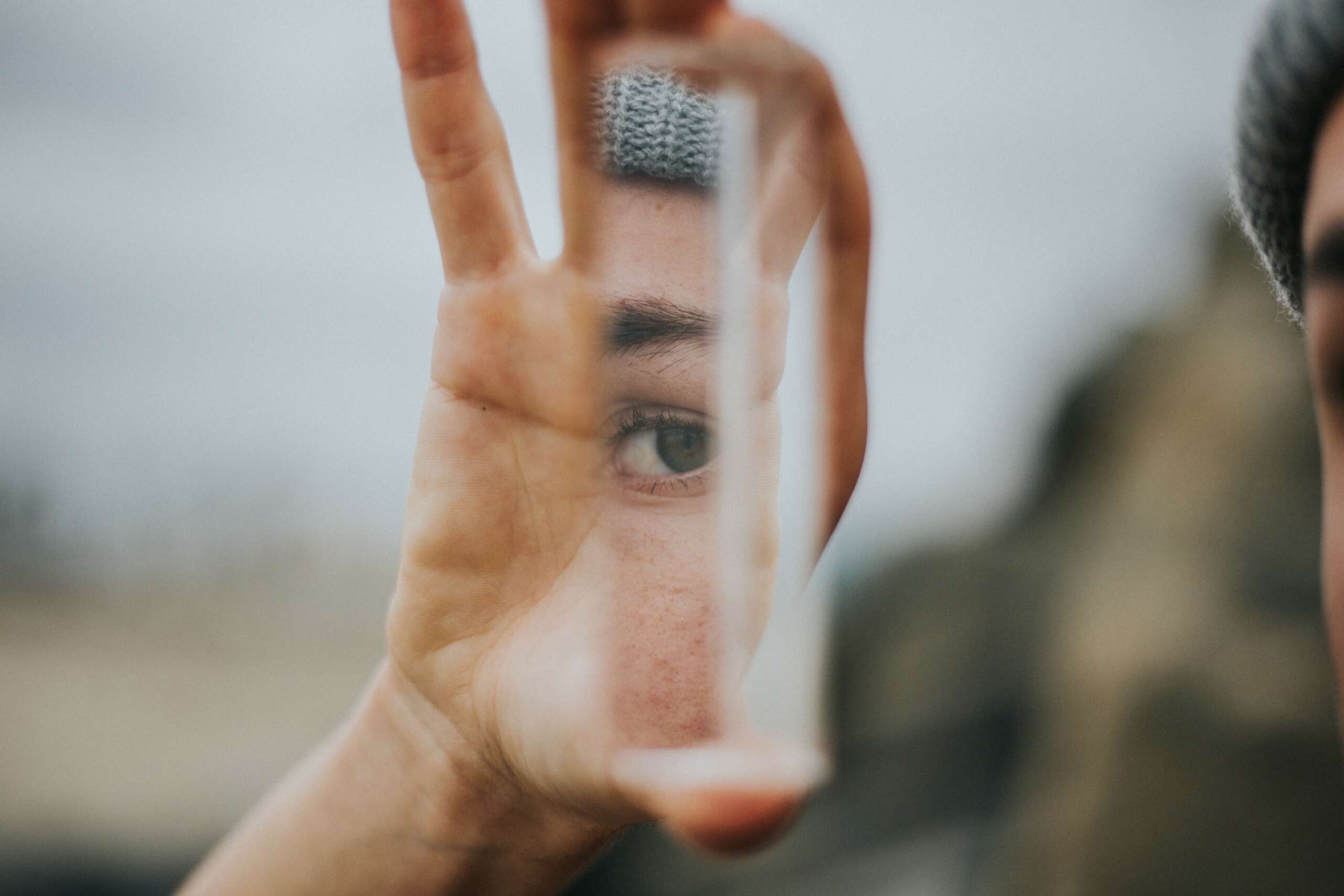Warning: Reference to statistics in suicides included.
As I sat down to write this week’s post, my sister sent me the link to devastating yet shockingly unsurprising new research from the CDC.
The CDC’s Youth Risk Behavior Survey is fielded every two years to high schoolers across the United States. The results from its most recent study, which 17,000 adolescents took in the fall of 2021, were recently released.
There were several significant red flags, amongst which include:
- Nearly 60% of female and 70% of LGBQ+ students experienced persistent sadness or hopelessness. This is defined as feeling so sad or hopeless almost every day for at least two weeks in a row that they stopped doing their usual activities.
- Nearly 1 in 3 girls reported seriously considering suicide in the past year – a 60% rise from a decade ago.
As you can see in the graphs, the stress and isolation experienced during the pandemic only exacerbated issues hiding in plain sight.


And weirdly, some of the more positive stats from this study may not be so positive after all. The percentage of high school students having sex, drinking alcohol, and smoking weed all dropped. I now wonder if the decreases in the quintessential red flags of my youth only support the crisis of loneliness and belonging in our young people.
While the increases in these loneliness stats for girls are more pronounced than in boys, it’s unclear why. There is a theory that boys underreport these things due to their conditioning.
As I sat with that, I thought about connection, loneliness, and belonging. I started to imagine life 10 years down the road and how Smith would see connection and friendship as modeled by his parents. And where I am today is not the model I want to show my son. So I started to do some digging, and I will share what I found and my considerations for myself.
Why are People Lonelier than Ever?
Let’s start with some concepts that I will talk about throughout the post:
- Social connection – Comprises how individuals connect with other people and how they see themselves with respect to these associations. The need for social connection is a critical evolutionary milestone and objectively core to our being. From the time you were born, your survival and welfare depended on others.
- Loneliness – A subjective experience characterized as a negative social emotion and distressing feeling connected to some form of social relationship deficit.
- Belonging – “subjective feeling that one is an integral part of their surrounding systems” – Hagerty
Many researchers have charted loneliness against technology dating back to the 50s with the increase in the popularity of television correlating with an increase in loneliness. The advent of the iPhone and the mass proliferation of smartphones sent loneliness rates soaring.
Technology in and of itself isn’t the issue. In fact, some studies indicate that technology, when used in specific ways, makes us less lonely. But more often, these devices and the apps designed to keep us on them, give us an addictive false flag of connection.
Returning to our separate spaces, we get used to being alone and soon, we want more isolation, not less. Chronic social isolation leads to an increase in epinephrine and cortisol which can lead to anxiety, high blood pressure, stroke, and more. And one landmark study showed that a sustained lack of social connection is the equivalent of smoking 15 cigarettes a day.
Self-Esteem After Social Media
Those of us old enough to know the world before and after the advent of social media can see its effects more clearly. We didn’t grow up knowing everything that everyone was doing at every second via social media. We were left to imagine why we were missing out, not actually see it. Oooof.
It’s no surprise that social media lowers self-esteem, which can produce a constant feeling of loneliness and a feeling that everyone has a place they belong except for you.
So many things can cause low self-esteem, from abuse and trauma to societal pressures and expectations from living in a world of highlight reels and photo editing apps , and all of it can affect how we see ourselves.
I feel it! I see pictures of my friends on a wonderful, peaceful (and expensive) family vacation. Or catch a girls’ getaway that I wasn’t invited on. I see someone giving a speech at an event that I wanted. And when I’m not in a good place, those things can make me spiral.
I can’t even imagine what it’s like to be 15 and experience all of that in real time.
The Three Types of Loneliness
Researchers have distinguished different types of loneliness that I think are helpful to understand because, depending on your situation, you can start identifying what you may need to think about:
- Intimate loneliness occurs when you don’t have a deep relationship with someone you can turn to at all times. It doesn’t have to be a romantic partner. It could be a friend or family member you know will always be there for you.
- Relational loneliness is a the lack of a broader friendship circle. These may correspond with people you know from specific places like school or a sport or later in life, volunteering opportunities or other parents from your child’s school.
- Collective loneliness is a type of loneliness that happens when you lose all happenstance interactions. You are no longer running into people you know in the kitchen at work or in the grocery store.
Keep in mind that in our vocabulary, one word, “friend,” covers a wide range of needs. Think through how different types of friends can address these types of loneliness.
The Relationship Between Self-Esteem and Loneliness
Research indicates that people with low self-esteem can develop an attachment style that is anxious or avoidant.
Those with anxious attachment styles sacrifice themselves with others and put in a lot of effort without much reward and often take things personally and see rejection even when it’s not there.
Those with avoidant attachment styles may have a lot of shallow connections (that are easy to mistake for friends). They don’t really trust people, and they often will ghost on plans or try to sniff out when they are losing their autonomy in a relationship. They never want to be dependent on others.
Healthy attachment is called secure attachment, and the research indicates that it has decreased over time.
To combat loneliness, we need to examine not only our connection with others but our connection with ourselves.
The Guidance I Wrote For Myself
I am no expert on this, but using the research, I wrote a few pieces of guidance that I will continue to consider in my quest for friendship. I hope it’s helpful to you.
- Know when you need to be alone and when it’s time to stop being alone — I find it hard to do anything halfway. When I decide to focus on something, I go all in and can quickly lose balance. Understanding the signs of when I need to be alone (being tired and snippy are typically my signs) and taking that time is essential to being emotionally available for friendships.
- Increasing self-esteem and decreasing your loneliness can work together — The theory of Inclusion of Other in the Self says that when we get close to someone, we include them in our sense of self. So if you make friends with people with certain attributes you’d like to see in yourself, you not only combat loneliness but expand how you see yourself.
- Create belonging by asking for help — I was struck by the definition of belonging – being integral to a system. You can certainly have connections without feeling a sense of belonging. So often, we don’t ask for help from our friends when those moments can create true belonging. When our worth depends on being the hero, it’s time to consider whether anxious attachment is your M.O.
- Initiate — The stats would show that there aren’t many people running around perceiving that they have a bunch of good friends. We are all looking for friendship. I have been working on initiating connections to see if it may lead to friendship, not only because I need it for myself but because I want my son to know that behavior. I can sometimes carry a big chip on my shoulder because people rarely initiate with me. But when I’m happiest, I’ve put that down.
- Know that people like you more than you think — If you fear that someone won’t like you, consider the liking gap. This research says that we underestimate how much we are liked, and if you are REALLY self-critical, the research says people like you more.
- Mine your connections for friendships — Question the relationships you have today. Self-verification theory says that we seek out people who verify what we feel about ourselves. If you don’t like yourself, you may subconsciously find people that validate that experience, overtly or covertly. So you may have some people you consider friends, who maybe should only be acquaintances. Or the opposite…do you have acquaintances you’d like to be closer with?
In a culture that prioritizes the pursuit of wealth and success as well as romantic love, friendships can fall by the wayside. And as we struggle with self-esteem more than ever, the lack of true friends can keep us stuck in an endless cycle.
Together, let’s model for the next generation what it is like to have healthy friendships.
Self-Esteem and Loneliness Sources
Beresin, Eugene. Low Self-Esteem in Adolescents: What Are the Root Causes?… and what can adults do to help?. Psychology Today. 2022.
Passanisi, Allesia, Alessia Maria Gervasia, Carmela Madoniaa, Giovanni Guzzoa, Davide Grecoa. Attachment, Self-Esteem and Shame in Emerging Adulthood. Procedia Social and Behavioral Sciences. 2015.
Rokach, Ami and Joel O. Goldberg. Editorial: From Loneliness to Belonging – The Path We Hope to Take. Sec. Personality and Social Psychology. 2021.
Michelle H. Lim, Kelly-Ann Allen, Michael J. Furlong, Heather Craig & Doug C. Smith, Introducing a dual continuum model of belonging and loneliness, Australian Journal of Psychology. 2021.
CDC Youth Risk Behavior Survey Data Summary & Trends Report: 2011 – 2021
Ze-wei Ma, Jia-jie Liang, Wei-nan Zeng, Su Jiang, Tian Liu. The Relationship Between Self-Esteem and Loneliness: Does Social
Anxiety Matter?. International Journal of Psychological Studies. 2014.



